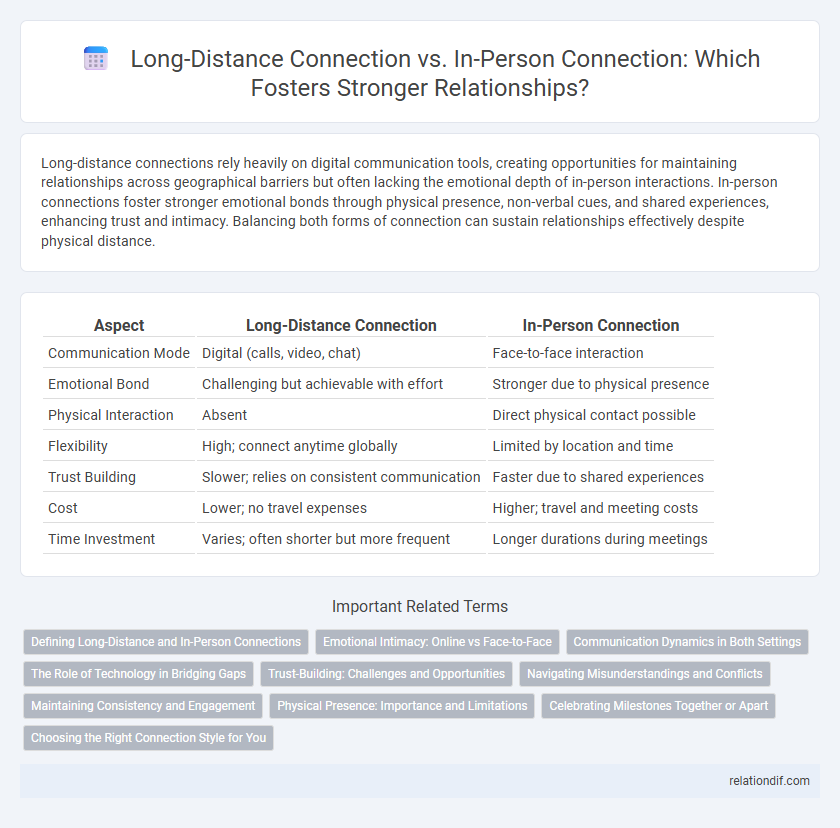Long-distance connections rely heavily on digital communication tools, creating opportunities for maintaining relationships across geographical barriers but often lacking the emotional depth of in-person interactions. In-person connections foster stronger emotional bonds through physical presence, non-verbal cues, and shared experiences, enhancing trust and intimacy. Balancing both forms of connection can sustain relationships effectively despite physical distance.
Table of Comparison
| Aspect | Long-Distance Connection | In-Person Connection |
|---|---|---|
| Communication Mode | Digital (calls, video, chat) | Face-to-face interaction |
| Emotional Bond | Challenging but achievable with effort | Stronger due to physical presence |
| Physical Interaction | Absent | Direct physical contact possible |
| Flexibility | High; connect anytime globally | Limited by location and time |
| Trust Building | Slower; relies on consistent communication | Faster due to shared experiences |
| Cost | Lower; no travel expenses | Higher; travel and meeting costs |
| Time Investment | Varies; often shorter but more frequent | Longer durations during meetings |
Defining Long-Distance and In-Person Connections
Long-distance connections involve communication and relationship maintenance across geographic separations, primarily using digital tools like video calls, messaging apps, and social media platforms that facilitate interaction despite physical distance. In-person connections occur when individuals interact face-to-face, enabling direct sensory experiences, nonverbal cues, and immediate emotional feedback, which often strengthen interpersonal bonds. Both forms have distinct advantages and challenges, with in-person connections offering richer emotional depth and long-distance connections providing flexibility and sustained contact despite spatial barriers.
Emotional Intimacy: Online vs Face-to-Face
Emotional intimacy in long-distance connections often relies on consistent digital communication, utilizing video calls and messaging apps to convey tone and emotion effectively. In-person connections enable richer non-verbal cues, such as body language and physical touch, fostering deeper emotional bonding. Studies show face-to-face interactions activate brain regions linked to empathy and trust more robustly than online exchanges, enhancing emotional closeness.
Communication Dynamics in Both Settings
Long-distance connection relies heavily on digital communication tools such as video calls, messaging apps, and social media platforms, which can limit non-verbal cues and create delays in response time. In-person connection allows for richer communication dynamics through direct eye contact, body language, and immediate feedback, fostering stronger emotional bonds. Both settings require different strategies to maintain effective communication, with long-distance interactions demanding more explicit verbal expressions and in-person connections benefiting from spontaneous interactions.
The Role of Technology in Bridging Gaps
Technology plays a pivotal role in bridging gaps between long-distance connections and in-person interactions by enabling real-time communication through video calls, instant messaging, and social media platforms. Digital tools like Zoom, FaceTime, and WhatsApp foster emotional closeness despite physical separation, enhancing intimacy and collaboration across geographic distances. These technological advances reduce feelings of isolation and maintain social bonds, proving essential in both personal relationships and professional environments.
Trust-Building: Challenges and Opportunities
Long-distance connections often face trust-building challenges due to the lack of non-verbal cues and immediate feedback, which can slow relationship development. In-person connections provide richer communication through body language and shared experiences, enhancing trust more quickly and effectively. Leveraging digital tools with video calls and consistent interaction can create opportunities to bridge trust gaps in remote relationships.
Navigating Misunderstandings and Conflicts
Long-distance connections often rely on digital communication, which can lead to misunderstandings due to lack of nonverbal cues, causing conflicts to escalate more easily. In-person connections benefit from immediate feedback and body language, facilitating quicker resolution of disagreements and clearer emotional expression. Developing active listening skills and explicitly clarifying intentions are crucial strategies for navigating conflicts in both long-distance and face-to-face relationships.
Maintaining Consistency and Engagement
Maintaining consistency in long-distance connections requires regular communication through digital platforms such as video calls, messages, and shared online activities to sustain engagement. In-person connections benefit from physical presence and non-verbal cues that naturally enhance emotional bonding and responsiveness. Both forms demand intentional effort to keep interactions meaningful and prevent feelings of detachment or neglect.
Physical Presence: Importance and Limitations
Physical presence enhances emotional bonding and nonverbal communication, elements often diminished in long-distance connections. Face-to-face interactions allow for immediate feedback and deeper empathy through body language, which digital communication cannot fully replicate. However, physical presence can be limited by geographic distance, making long-distance connection necessary despite its constraints.
Celebrating Milestones Together or Apart
Celebrating milestones together creates stronger emotional bonds through shared experiences and immediate expressions of joy, fostering a deeper sense of connection. Long-distance connections rely on virtual tools to bridge the gap, allowing for meaningful celebrations despite physical separation, though they often lack the tactile and spontaneous interactions of in-person gatherings. Both forms of connection play vital roles in maintaining relationships, with in-person celebrations offering irreplaceable intimacy and remote celebrations emphasizing adaptability and continued commitment.
Choosing the Right Connection Style for You
Choosing the right connection style depends on individual needs, contexts, and relationship goals, weighing long-distance connection's flexibility against the tangible intimacy of in-person connection. Long-distance relationships benefit from digital communication tools like video calls and messaging apps, which maintain emotional closeness despite physical separation. In-person connection fosters non-verbal cues, shared experiences, and immediate support, crucial for deepening trust and emotional bonding.
long-distance connection vs in-person connection Infographic

 relationdif.com
relationdif.com